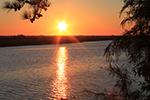 |
Santee River
Our first stop was at the highway median then walked across the highway to photograph Santee River at sunrise. I must confess this was the first time I’ve ever parked at such a place. Good thing it was not my truck, although we had no problem with highway patrol. It was a nice stop, although the landscape was rather flat, making photographing with my regular lens not very exciting. However, as we returned to the truck, Walter pointed out an eagle in the sky. The eagle perched on a dead tree giving us great photo compositions as the sun began above the horizon. According to USGS, the Santee River is the second largest river on the eastern coast of the United States, second only to the Susquehanna River in drainage area and flow. I suspect my local friends might not know this either J. In this low country region, the water is brackish and affected by tides. Our photo spot was right at the highway overpass of the river, just a couple of miles north of the Santee Coastal Reserve. |
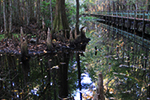 |
Santee Coastal Reserve
After our sunrise photo shoot at Santee River, Walter guided us to Santee Coastal Reserve to photograph swamps and cypress knees. The Santee Coastal Reserve Wildlife Management Area is managed by the South Carolina Department of Natural Resources (DNR). There is a campground, an old gun club and miles of biking and walking trails. The dirt roads and trails unfortunately did not go well with Norman's new truck interior after the hikes. I’m sure he’d clean it up before his wife finds out.
The sun was already fairly high in the sky to get good compositions. I managed to get some good reflection shots with indirect sunlight. With his long lens, I hope Walter got better shots. There are many interesting things to learn and do. Washo Reserve seems to be a good landscape and wildlife location in the right lighting and time of year. Washo Reserve, owned and co-managed by The Nature Conservancy, is a 1,040-acre sanctuary within Santee Coastal Reserve consisting of a cypress lake and surrounding upland longleaf pine buffer. The impounded cypress lake harbors the oldest wading bird rookery in continuous use in North America. Learn more about Washo Reserve. |
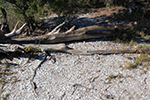 |
Sewee Shell Mounds
We visited this interesting prehistoric Indian site where mounds of oyster and clam shells were built (or dumped) some 4000 years ago. In addition to the established interpretive sites on the trail, Walter also took us on a marsh walk over muddy terrain to reach two more mounds, one of which still containing pottery remains from ancient time. Someone obviously ate a lot of oyster and clams, evidenced by the huge mounds at several locations which are still hill-high today after thousands of years. Walking this muddy marsh was not easy. I had to tie my tennis shoes very tight to keep it from being lodged in the mud. Fortunately, we cut across the forest on dry ground on the way back to the truck, which also helped cleaned some mud off the shoes before we climbed in the truck. Sewee Indians lived in this area for thousands of year. History books suggest that they might be the first natives to meet English settlers in 1670’s, and even assisted the English to fight off the Spanish. As far as the shell rings are concerned, there have been debates among archaeologists about their origins and purposes. Some believed it was for ceremonial purposes, while others thought they were just ancient dumps. More info about Sewee Shell Mound and Sewee history here. |
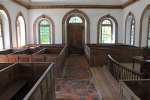 |
St. James-Santee Episcopal Church
Brick Church at Wambaw
There have been at least 6 church buildings in the St. James Santee Parish since 1687, with the Brick Church being the 4th which was built in 1768 on the King’s Highway. It was called Wambaw Church after the nearby creek and is now known locally as Old Brick Church. The body of the church was built of brick imported from England, but the columns of the portico were constructed of local wedge-shaped bricks. The church was strongly associated with the Huguenot immigrants who first settled the area and has been known variously as “The French Church” and as the “church of the Huguenots.” |
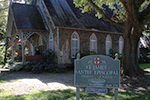 |
Chapel of Ease for Wambaw Church - In 1890, the St. James Santee Episcopal Chapel of Ease was built in McClellanville. Residents of the area donated the land and the funds required to build the Chapel - while others contributed architectural and carpentry skills. The Chapel was framed in longleaf pine and cypress - with black cypress shingles covering the roof and exterior walls.
|




